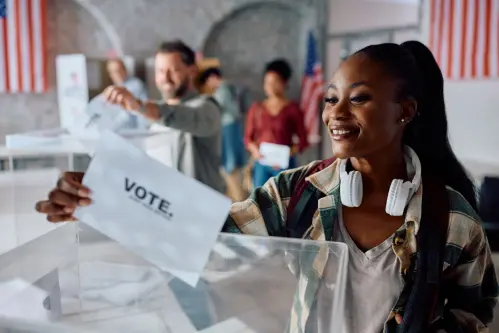

12:30 pm EDT - 1:00 pm EDT
Past Event
12:30 pm - 1:00 pm EDT
1775 Massachusetts Ave., NW
Washington, DC
College students across the country are waiting anxiously as the Senate struggles to find compromise over the interest rates on federally subsidized Stafford loans. Set to double on July 1, lawmakers agree that the rates should be kept at current levels, but cannot come to bipartisan agreement over how to pay for the program.
Will the Senate achieve compromise before the July 1 deadline? What’s next for America’s college students if the interest rates on these loans are doubled? On May 30 at 12:30 p.m., Brookings expert Matthew Chingos took your questions and comments in a live web chat moderated by Vivyan Tran of POITICO.
12:30 Vivyan Tran: Welcome everyone, let’s get started!
12:30 [Comment From Saori:] How many students will be affected if the rates rise on July 1?
12:31 Matthew Chingos: The White House claims that 7 million students will be affected, but the actual number will depend on how long the rate is extended for because it only applies to new subsidized loans issued after July 1.
12:32 [Comment From Roberto:] Are rate increases really even an option? I feel like we’d have mass dropouts at America’s colleges.
12:34 Matthew Chingos: Yes, a rate increase is a viable option at least in terms of policy (but maybe not politically). The rate being debated only applies to one type of federal loan (new subsidized loans). The rate has only been at its current level of 3.4% for a short period of time; just a few years ago it was 6.8%. The implications for student debt of a rate increase back to 6.8% are modest — the White House estimates about $1,000 per student over the life of the loan. That’s not nothing, but it’s unlikely to cause dropouts now because it only affects how much students have to pay back after they leave college.
12:34 [Comment From Anne:] Why are Republicans and Democrats having such a difficult time coming to an agreement over the future of the Stafford loan program?
12:35 Matthew Chingos: It seems that Republicans and Democrats are having a difficult time agreeing over pretty much everything these days! I’d chalk it up to increasing polarization of the parties combined with the usual election-year politics.
12:36 [Comment From Guest:] Will this have any effect on unsubsidized federal student loans?
12:36 Matthew Chingos: No, the rate currently being debated by Congress is only for subsidized loans — it will not affect unsubsidized loans.
12:37 [Comment From Felicity:] It seems that the debate over the interest rates on federal student loans is more of an election-year game. Isn’t the real issue the principal on private student loans? That is the crisis, right?
12:39 Matthew Chingos: Yes, this is election-year politics at its worst. Loan principal is a big issue for many students, and one idea worth considering is to eliminate the protection that student loans receive during bankruptcy.
12:39 [Comment From Gianne:] Is the student loan debate another sign that Washington is broken? Shouldn’t this be a fairly easy problem to fix?
12:39 Matthew Chingos: It’s easy for Congress to vote to keep the interest rate on subsidized loans at 3.4%, but actually coming up with a smarter, better higher-ed policy is much more complicated!
12:40 [Comment From CJ:] Are either of the presidential candidates providing leadership on this issue?
12:41 Matthew Chingos: No, I think they’re both engaging in cheap political theater to try and win the votes of college students.
12:41 [Comment From Andrew:] How will this affect the future workforce? Will there be an increase of non-college graduates, and will the future economy be able to support that influx?
12:42 Matthew Chingos: I don’t think whether the rate is 3.4% or 6.8% will have much of an impact on the future workforce.
12:43 [Comment From Eric, CA:] If you could propose a plan to the next president, how would you reform or fix the nation’s college loan program? Is a 3 percent rate even too high?
12:44 Matthew Chingos: I think loans should be guaranteed by the federal government, but that interest rates should be market rates. The federal government should continue to subsidize low-income college students through programs like Pell (which provide grants to directly reduce the cost of college). The federal government also should require colleges to provide better information to potential students about things like graduation rates and the labor-market outcomes of their graduates.
12:45 [Comment From Steve:] Would you say the real problem is the cost of education, not interest rates? Can the U.S. government do anything to address how much universities are charging for tuition if those schools are taking federal student aid?
12:46 Matthew Chingos: I agree that the rising cost of college is the real issue for students and their families. I think that the kind of information provision I mentioned in my previous comment is one way to force colleges to compete on quality and cost — rather than on amenities that drive up costs.
12:46 [Comment From Andrew:] It sounds like the rate isn’t a significant increase, but what about the families who are struggling to get a child through college at the current rates? I would think they have the most to lose.
12:47 Matthew Chingos: The interest rate on loans doesn’t affect how much families have to pay now, but rather how much students have to pay back after they graduate from college (or drop out).
12:47 [Comment From Felicity:] Since both universities and the economy benefit from higher-ed, how come all the risk of higher education is placed on students? It seems that the market is out of control and low-income/lower-middle class students are bearing the brunt of it.
12:49 Matthew Chingos: I don’t think students bear all of the risk — taxpayers do too through federal and state grant programs and the federal subsidized loan programs. But I think it is worth finding ways to ensure that colleges and universities have more “skin in the game” in terms of the success of their students.
12:50 [Comment From Ann:] Hasn’t the loan guarantee part of the federal student-loan program ended? I believe all new loans are direct student loans.
12:51 Matthew Chingos: That’s correct — what I meant was that it is important that the federal government provides loans to students because many do not have the kind of credit history or collateral that would be needed on the private market.
12:51 [Comment From Eduard:] What about state grant programs? Is that an area where states can step in if Congress can’t come to an agreement?
12:52 Matthew Chingos: State grant programs do have an important role to play in making college affordable for students (see my recent Brookings report on this issue with Sandy Baum and other members of the Brookings State Grant Aid Study Group).
12:52 [Comment From Nancy:] If student loans increase, could we see an increase of students doing online or distance-based higher education? And what kind of quality do these programs offer?
12:54 Matthew Chingos: I don’t think the interest rate on subsidized loans will have much of an impact on college-going behavior, but we are already seeing increases in online and distance-based higher education. The quality of such programs is uneven, but I think they have the potential to improve in the future. I just released a study showing that an interactive online statistics course produced similar learning outcomes to the traditional, face-to-face version of the same course on public university campuses.
12:54 [Comment From Gen:] Isn’t the bigger issue here more about getting access to these loans in the first place? Will this rate increase change who is qualified for these loans?
12:56 Matthew Chingos: No, the rate change will not impact who is eligible for these subsidized loans. In addition to the subsidized loans, all students are eligible for unsubsidized loans. These two kinds of loans used to have the same interest rate — the difference was that subsidized loans do not accumulate interest while the student is still in college. Now the subsidized loans have the additional subsidy of the lower rate — at least until July 1.
12:56 [Comment From Melissa, MD:] How do we encourage students to complete their education in four years – or even early? It seems as though that could drive a huge savings for students.
12:57 Matthew Chingos: I agree that this is tremendously important. Time-to-degree has increased dramatically in recent years, at a significant cost to students, their families and the taxpayers who subsidize them. One promising approach is to tie grant dollars to on-time progress toward degree completion, as the West Virginia PROMISE program has done.
12:57 [Comment From Ann:] I believe there was a period of time when federal student loan rates were variable (I can’t remember if they were tied to CP rates or T-Bill rates) – is that a viable alternative to the current fixed-rate structure?
12:58 Matthew Chingos: I think students should have access to both fixed- and variable-rate loans (with the rates determined by prevailing market conditions), just as homebuyers have access to fixed- and variable-rate loans.
12:59 [Comment From skewman:] The kids themselves don’t even understand any of the consequences of this, do they?
1:00 Matthew Chingos: Many students are not provided with clear, accurate and timely information about the cost of college. And those that do don’t usually find out the “net price” (the “sticker price” minus financial aid) until shortly before they have to decide where to enroll. Improving the information provided to students is very important.
1:00 Vivyan Tran: Thanks for all the questions, see you next week!
12:30 pm - 1:00 pm
Will the Senate achieve compromise before the July 1 deadline? What’s next for America’s college students if the interest rates on these loans are doubled? On May 30, Brookings expert Matthew Chingos took your questions and comments in a live web chat moderated by Vivyan Tran of POITICO.


Lydia Wilbard
August 29, 2024

Zachary Billot, Annie Vong, Nicole Dias Del Valle, Emily Markovich Morris
August 26, 2024

Brian A. Jacob, Cristina Stanojevich
August 26, 2024